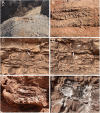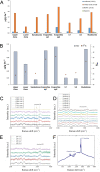Dark microbiome and extremely low organics in Atacama fossil delta unveil Mars life detection limits
- PMID: 36810853
- PMCID: PMC9944251
- DOI: 10.1038/s41467-023-36172-1
Dark microbiome and extremely low organics in Atacama fossil delta unveil Mars life detection limits
Abstract
Identifying unequivocal signs of life on Mars is one of the most important objectives for sending missions to the red planet. Here we report Red Stone, a 163-100 My alluvial fan-fan delta that formed under arid conditions in the Atacama Desert, rich in hematite and mudstones containing clays such as vermiculite and smectites, and therefore geologically analogous to Mars. We show that Red Stone samples display an important number of microorganisms with an unusual high rate of phylogenetic indeterminacy, what we refer to as "dark microbiome", and a mix of biosignatures from extant and ancient microorganisms that can be barely detected with state-of-the-art laboratory equipment. Our analyses by testbed instruments that are on or will be sent to Mars unveil that although the mineralogy of Red Stone matches that detected by ground-based instruments on the red planet, similarly low levels of organics will be hard, if not impossible to detect in Martian rocks depending on the instrument and technique used. Our results stress the importance in returning samples to Earth for conclusively addressing whether life ever existed on Mars.
© 2023. The Author(s).
Conflict of interest statement
The authors declare no competing interests.
Figures





References
-
- Thomson BJ, et al. Constraints on the origin and evolution of the layered mound in Gale Crater, Mars using Mars reconnaissance orbiter data. Icarus. 2011;214:413–432. doi: 10.1016/j.icarus.2011.05.002. - DOI
-
- Goudge TA, et al. Sedimentological evidence for a deltaic origin of the western fan deposit in Jezero crater, Mars and implications for future exploration. Earth Planet. Sci. Lett. 2017;458:357–365. doi: 10.1016/j.epsl.2016.10.056. - DOI
Publication types
MeSH terms
LinkOut - more resources
Full Text Sources
Miscellaneous

